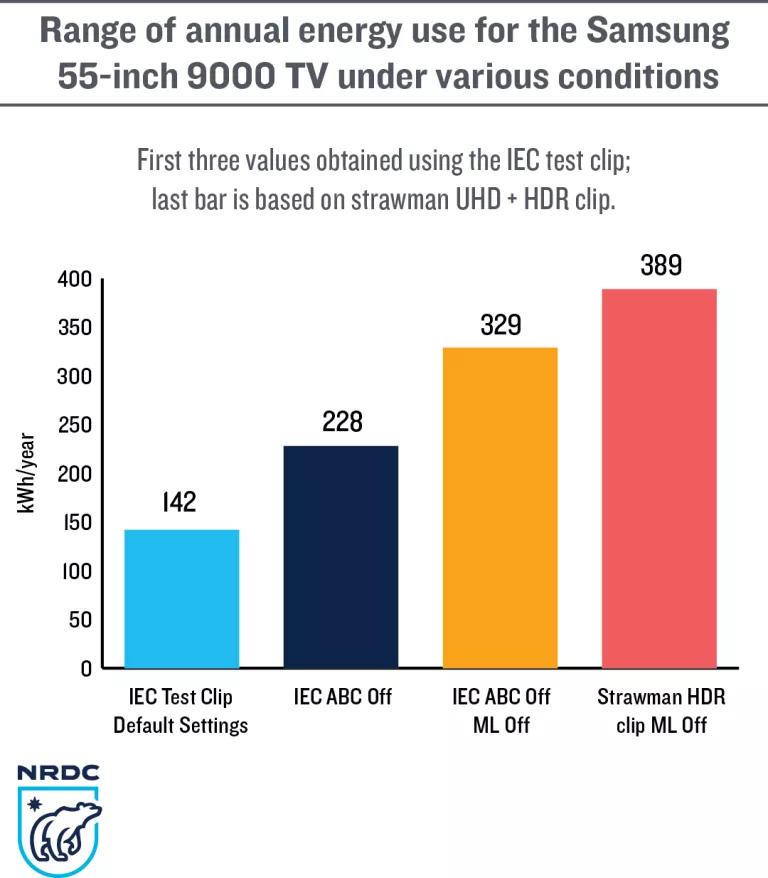TVs May Be Consuming $1.2 Billion More Energy Than Expected

Many recently purchased TVs could cost consumers $1.2 billion more on their electricity bills than they anticipated over their television’s lifetime, according to a Natural Resources Defense Council (NRDC) study published today. The higher costs are due to flaws in the U.S. Department of Energy (DOE) method for measuring TV energy use that the three biggest TV manufacturers—Samsung, LG, and Vizio—appear to be exploiting.
As a result, most of the models sold by these companies, which together represent half the U.S. market, often look more energy efficient during the official government test—a level reflected on their yellow EnergyGuide label—than in actual use. The same energy consumption results are used to determine whether a product qualifies for the ENERGY STAR® label indicating it is among the more energy efficient available, and to determine compliance with mandatory efficiency standards in California and a few other states. (There are no national TV energy efficiency standards.)
We found the 10-minute “test loop” of content used in the DOE protocol to measure energy use contains abnormally short scenes and more frequent scene cuts than what is normally viewed on television. Samsung and LG televisions have a motion-detection dimming (MDD) feature that can significantly reduce energy use during such choppy scenes, resulting in low energy test scores even though they consume more energy when content with more typical scene lengths is played.
The TVs from Samsung, LG, and Vizio also are programmed to automatically disable the key energy-saving features of MDD and automatic brightness control—which adjusts the energy level in reaction to the room’s ambient light—whenever a user changes the default picture setting (such as from Normal to Sports or Vivid). Manufacturers are likely doing this to further increase the brightness of the television screen in an attempt to improve perceived owner satisfaction, but the resulting extra energy use is not accounted for in the DOE test. And in most cases, users receive little or no on-screen warning that energy consumption will significantly increase.
However, a few seemingly innocuous clicks on a remote control can as much as double the cost to operate a television, adding $100 to $200 in operating costs over its 10-year lifetime. In addition, testing done by NRDC and our consultant Ecos Research showed that if the user makes only a slight change to the contrast, backlight, or brightness settings of some Samsung TVs, the energy-saving features also are disabled. (Samsung tells us it is discontinuing this practice.)
While these actions may not be illegal, they smack of bad-faith conduct that falls outside the intent of the DOE test method designed to accurately measure TV energy use.
Assuming one-third of the owners of newer LG, Samsung and Vizion TVs with screens 32 inches and larger adjusted the main picture setting, they will consume almost 10 terawatt-hours (TWh) of additional electricity over their lifetimes. This is equivalent to the electricity consumed every year by all the homes in Los Angeles and translates into more than 5 million metric tons of additional carbon dioxide emissions, the heat-trapping pollutant responsible for climate change.
How did we identify these problems?
While conducting a 2015 study of the energy use of new ultra high-definition (UHD) TVs, also sometimes referred to 4K because of their nearly 4,000 horizontal pixels, we observed unexplainable dramatic and sustained drops in power use within the first minute of the DOE test loop. To better explain these anomalies and the energy use of some of the newest TV features, NRDC and Ecos performed laboratory testing in 2015 and 2016 under a range of conditions on one LG and two Samsung TVs, the only two brands believed to have motion detection dimming, as well as a high-end Vizio model capable of playing content produced in Dolby Vision.
We used the International Electrotechnical Committee (IEC) video loop referenced by DOE to test the TVs as received in their default settings, and after one or more of the energy-saving features became disabled. We then tested them with a “test loop” we created with more typical content and which was found to have fewer short scenes. In addition, we measured the TVs’ energy use with movies produced in various formats of High Dynamic Range (HDR) including Dolby Vision. Separately, we conducted in-store testing on 21 different 2015 and 2016 models from a wider range of brands to assess the persistence of their energy-saving features after the picture setting was changed.
Our key findings include:
- Samsung and LG TVs’ MDD feature saved much more energy during the DOE test than with real-world content. While MDD caused “on mode” power to drop by 58 percent on the LG TV we tested, it only dropped by 13 percent when playing the real world content loop. (This effect was smaller for the Samsung TVs.) We believe LG and Samsung may be exploiting the abnormally high frequency of scene changes in the IEC test loop to obtain a better energy efficiency score on the DOE test.
- The energy-saving features in Samsung, LG, and Vizio TVs are automatically disabled, with little or no on-screen warning, if the user changes the picture setting. Almost all TV manufacturers include ABC, which our earlier study found can reduce energy use by 17 to 93 percent, depending on the model. In addition, Samsung and LG TVs often have MDD, although they use different terms for it. We found that in most recent Samsung, LG, and Vizio TVs, these energy-saving features were automatically disabled if the main picture setting was changed. The manufacturers we’ve spoken to agreed, to varying levels, to update the software on their new TVs so the energy-saving features are more likely to remain enabled. LG has been the most responsive to our concerns.
- Playing HDR movies on an HDR-capable TV is likely to cause a significant increase in national energy consumption. Our testing while playing a few different movies on a few TVs showed energy use increased by roughly 30 to 50 percent with the UHD + HDR version compared to a movie produced in UHD. Manufacturers indicated to us that their HDR-ready TVs temporarily disable energy-saving features whenever the new UHD + HDR format is played, and our testing confirms that. We assume this is done to pump up the brightness of the backlight. The DOE test does not include HDR content, which is anticipated to achieve broad market adoption due to its bolder colors, brighter highlights, and increased contrast.
- There are numerous ways a TV’s annual energy use can double, often without the user’s knowledge, from the published values. As noted earlier, energy-saving features are automatically turned off on some models when certain picture settings are changed. For the Samsung 9000 model, playing the IEC test clip resulted in annual energy use of 142 kilowatt-hours (kWh) per year. This changed to 228 kWh/yr when ABC was disabled; to 329 kWh/yr when ABC and motion lighting were disabled; and went all the way up to 389 kWh/yr with a clip of HDR content. These are huge increases not captured by the DOE test method.

To help ensure the government’s TV energy use testing better represents actual consumption, we recommend:
- Manufacturers discontinue their inappropriate practice of automatically disabling energy-saving features when a picture setting is changed.
- The DOE test method be updated to include: a) content with scene lengths more representative of typical content and less susceptible to detection by the TV during testing, and b) a version in UHD + HDR. DOE also should provide clear guidance on how to address the lack of persistence of energy-saving features. The agency is investigating the test method’s limitations and we are optimistic it will make the necessary revisions.
- Consumers should restore the energy-saving features, in particular automatic brightness control, and avoid overly bright and power-consumptive picture settings like Vivid or Dynamic that can yield sub-optimal viewing experiences.
- The U.S. Environmental Protection Agency should move forward with updating its ENERGY STAR® specifications for TVs, and continue its verification and enforcement efforts to preserve the brand’s well-deserved integrity and value.
- The TV industry should make it a priority to limit the extra energy consumption by TVs capable of displaying the emerging HDR technology.



